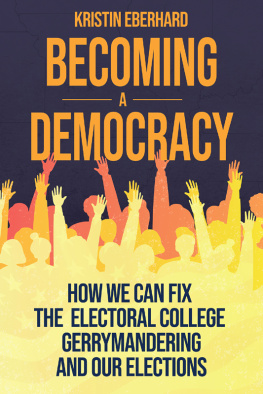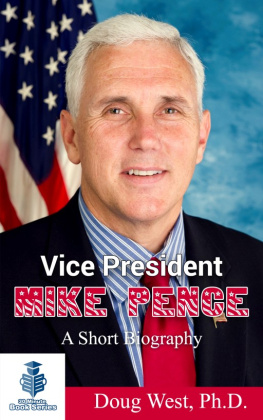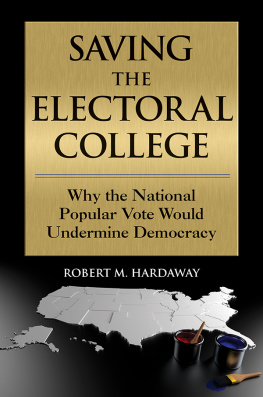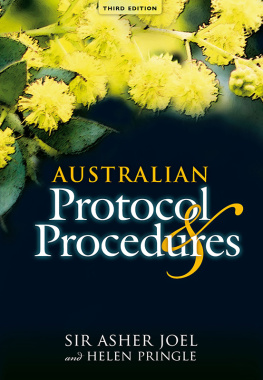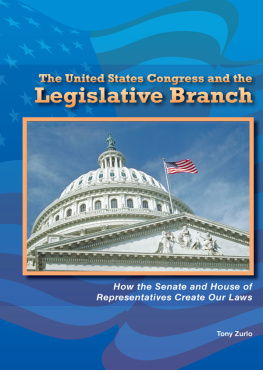Electing the House
Electing the House
The Adoption and Performance of the US Single-Member District Electoral System
Jay K. Dow
2017 by the University Press of Kansas
All rights reserved
Published by the University Press of Kansas (Lawrence, Kansas 66045), which was organized by the Kansas Board of Regents and is operated and funded by Emporia State University, Fort Hays State University, Kansas State University, Pittsburg State University, the University of Kansas, and Wichita State University
Library of Congress Cataloging-in-Publication Data
Names: Dow, Jay K. (Jay Kent), 1962 author.
Title: Electing the House : the adoption and performance of the US single-member district electoral system / Jay Kent Dow.
Description: Laurence, Kansas : University Press of Kansas, [2017] | Includes bibliographical references and index.
Identifiers: LCCN 2016047597
ISBN 9780700624096 (cloth : acid free paper)
ISBN 9780700624102 (pbk. : acid free paper)
ISBN 9780700624119 (ebook)
Subjects: LCSH: United States. Congress. HouseElection districtsHistory.
Classification: LCC JK1341 .D69 2017 | DDC 328.73/07345dc23
LC record available at https://lccn.loc.gov/2016047597.
British Library Cataloguing-in-Publication Data is available.
Printed in the United States of America
10 9 8 7 6 5 4 3 2 1
The paper used in this publication is recycled and contains 30 percent postconsumer waste. It is acid free and meets the minimum requirements of the American National Standard for Permanence of Paper for Printed Library Materials z39.481992.
CONTENTS
ILLUSTRATIONS
Image and Figures
Tables
PREFACE AND ACKNOWLEDGMENTS
The idea for this book took shape when I was privileged to attend two Jack Miller Center Summer Institutes on teaching Americas founding principles and history. I was surprised by my inclusion in the programs because, although I taught a class in founding-era political thought at the University of Missouri, I had made my academic career on statistical studies of electoral systems in contemporary elections. These institute conversations with some of the leading graduate students and faculty in American political thought and development made me realize that I couldnt provide a satisfactory answer to the simple question of how and why we came to elect the House of Representatives as we do. Ive always believed one of the primary benefits of the academic profession is that one can pursue ones intellectual interests wherever they lead, and my interests were shifting from the contemporary performance and political implications of election systems to understanding their origins and development. I had been recently promoted to full professor and was in a good position to read and learn as much as I could about the political thought on elections in the early republic, American political development, and the long history of congressional elections. This book is the beginning of that process.
On its face my academic pedigree suggests that Im best suited for my original vocation of statistical analyses of electoral systems. I completed my dissertation under the guidance of Mel Hinich at the University of Texas at Austin, and Mel was one of the most accomplished scholars of his generation in this field of inquiry. However, I was also greatly influenced by Walter Dean Burnham, and his presence is felt throughout the manuscript. Dean Burnham taught me many things, including that one needs to understand history to place empirical findings in context and that one can gain great insights from very basic electoral data and simple analysis. This book owes much to Dean Burnhams influence a full quarter-century after I last took a seminar from him.
More immediately, I am deeply indebted to the University of Missouri Kinder Institute on Constitutional Democracy for providing financial assistance that allowed me to conduct research at Chicagos Newberry Library and, more importantly, for creating a campus-wide network of scholars interested in basic questions of US constitutional governance. The Kinder Institute provides a forum for the collaboration and discussion of ideas among scholars from different academic backgrounds and perspectives, all of whom share a deep commitment to constitutional democracy and the American polity. In this, I owe particular acknowledgments to my colleagues Justin Dyer and historian of the early republic Jeff Pasley. Professors Dyer and Pasley codirect the Kinder Institute and were instrumental in establishing the intellectual environment where I could discuss the ideas in this book. I am also indebted to Pev Squire, who shared his considerable expertise on the development of American legislatures as I pursued my inquiry on their election. These conversations in conferences, colloquia, seminars, and department hallways moved this project forward in a way that would not have been possible otherwise. I also benefited from the assistance of the University of Missouri Research Council, which granted me a research leave to write. The Research Council also funded my work at the National Archives Center for Legislative Archives, where I obtained material that provided richer context for several chapters. In acknowledging Research Council support, I am simultaneously recognizing the assistance of my former department chair, John Petrocik. This gentleman had to support me and the project for it to secure institutional backing, and I very much appreciate his effort on my behalf.
Finally, the most significant acknowledgments and deepest expressions of gratitude go to my family, including daughters Rachelle and Laurel and, especially, my wife, Debbie. Debbie did not marry a scholar. She married a guy barely out of high school who over the course of our thirty-five-year marriage slowly became one. Her patience and support in this process is incalculable and extends well beyond anything specific to this project. For that and everything else I am profoundly grateful.
House of Representatives Elections and American Political Development
We are all Republicans, we are all Federalists.
Thomas Jefferson, first inaugural address
The United States elects its House of Representatives from single-member districts using the plurality rule. This method selects the candidate with the most votes, even if less than a majority, from a geographically contiguous district. This electoral system is an anomaly. For most of the world, an electoral systemthe rules by which citizens votes are translated into legislative seatsmeans proportional representation. Of the worlds approximately thirty or so established and unquestioned democracies, only fourthe United Kingdom, India, Canada, and the United Statesrely exclusively on single-member district (SMD) plurality rule to elect their national legislature. For the United States perhaps the more striking fact is that nowhere is this mandated. The Constitution grants the states the authority to elect representatives in the manner of their choosing, subject to restrictions that Congress may choose to impose.
In the nations early years the states exercised this privilege and elected their representatives using a variety of methods. For example, New Jersey elected its representatives at-large for the first five congresses, then changed to SMD, then reinstituted at-large elections, and finally opted for dual-member-district elections (DMD) from 1812 to 1814, after which it used at-large elections. Vermonts representatives were elected from single-member districts until the Thirteenth Congress, when the state switched to at-large elections, until the Seventeenth Congress when it used single-member districts for one cycle before reinstating at-large elections. New York relied on SMD during much of this period, but created some multimember constituencies in the early nineteenth century. In contrast, Virginia relied exclusively on SMD elections to elect its representatives in the early republic. The Virginia exception aside, fluidity in House election methods was the rule, not the exception, in the nations early years. Congress eventually asserted its prerogative in the mid-nineteenth century and required states to elect their representatives from single-member districts. This practice, now as much by tradition as by law, is well established.


